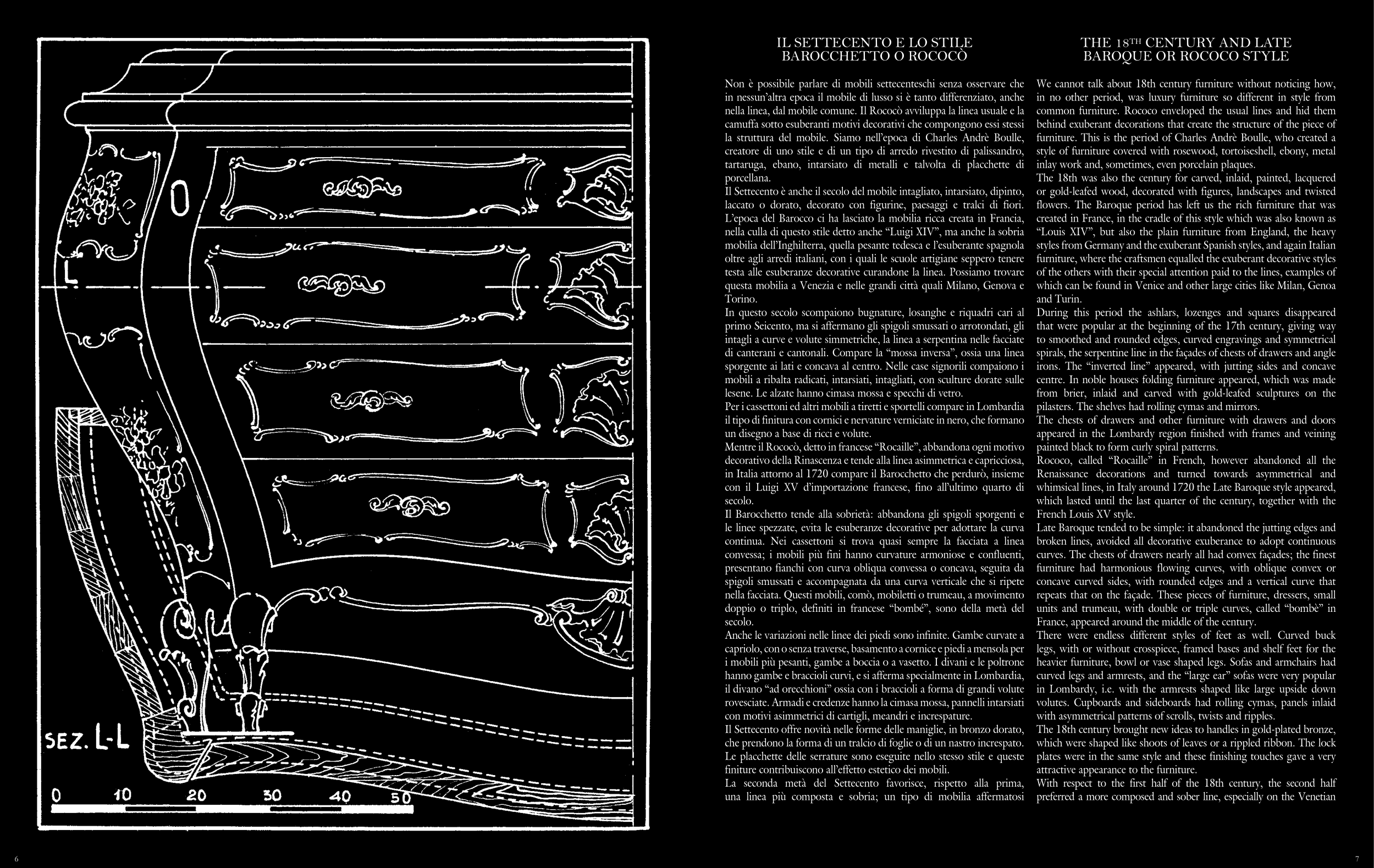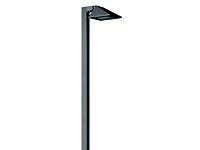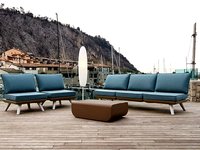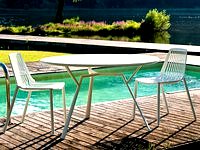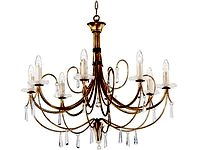IL SETTECENTO E LO STILE
BAROCCHETTO O ROCOCÒ
Non è possibile parlare di mobili settecenteschi senza osservare che
in nessun’altra epoca il mobile di lusso si è tanto differenziato, anche
nella linea, dal mobile comune. Il Rococò avviluppa la linea usuale e la
camuffa sotto esuberanti motivi decorativi che compongono essi stessi
la struttura del mobile. Siamo nell’epoca di Charles Andrè Boulle,
creatore di uno stile e di un tipo di arredo rivestito di palissandro,
tartaruga, ebano, intarsiato di metalli e talvolta di placchette di
porcellana.
Il Settecento è anche il secolo del mobile intagliato, intarsiato, dipinto,
laccato o dorato, decorato con figurine, paesaggi e tralci di fiori.
L’epoca del Barocco ci ha lasciato la mobilia ricca creata in Francia,
nella culla di questo stile detto anche “Luigi XIV”, ma anche la sobria
mobilia dell’Inghilterra, quella pesante tedesca e l’esuberante spagnola
oltre agli arredi italiani, con i quali le scuole artigiane seppero tenere
testa alle esuberanze decorative curandone la linea. Possiamo trovare
questa mobilia a Venezia e nelle grandi città quali Milano, Genova e
Torino.
In questo secolo scompaiono bugnature, losanghe e riquadri cari al
primo Seicento, ma si affermano gli spigoli smussati o arrotondati, gli
intagli a curve e volute simmetriche, la linea a serpentina nelle facciate
di canterani e cantonali. Compare la “mossa inversa”, ossia una linea
sporgente ai lati e concava al centro. Nelle case signorili compaiono i
mobili a ribalta radicati, intarsiati, intagliati, con sculture dorate sulle
lesene. Le alzate hanno cimasa mossa e specchi di vetro.
Per i cassettoni ed altri mobili a tiretti e sportelli compare in Lombardia
il tipo di finitura con cornici e nervature verniciate in nero, che formano
un disegno a base di ricci e volute.
Mentre il Rococò, detto in francese “Rocaille”, abbandona ogni motivo
decorativo della Rinascenza e tende alla linea asimmetrica e capricciosa,
in Italia attorno al 1720 compare il Barocchetto che perdurò, insieme
con il Luigi XV d’importazione francese, fino all’ultimo quarto di
secolo.
Il Barocchetto tende alla sobrietà: abbandona gli spigoli sporgenti e
le linee spezzate, evita le esuberanze decorative per adottare la curva
continua. Nei cassettoni si trova quasi sempre la facciata a linea
convessa; i mobili più fini hanno curvature armoniose e confluenti,
presentano fianchi con curva obliqua convessa o concava, seguita da
spigoli smussati e accompagnata da una curva verticale che si ripete
nella facciata. Questi mobili, comò, mobiletti o trumeau, a movimento
doppio o triplo, definiti in francese “bombé”, sono della metà del
secolo.
Anche le variazioni nelle linee dei piedi sono infinite. Gambe curvate a
capriolo, con o senza traverse, basamento a cornice e piedi a mensola per
i mobili più pesanti, gambe a boccia o a vasetto. I divani e le poltrone
hanno gambe e braccioli curvi, e si afferma specialmente in Lombardia,
il divano “ad orecchioni” ossia con i braccioli a forma di grandi volute
rovesciate. Armadi e credenze hanno la cimasa mossa, pannelli intarsiati
con motivi asimmetrici di cartigli, meandri e increspature.
Il Settecento offre novità nelle forme delle maniglie, in bronzo dorato,
che prendono la forma di un tralcio di foglie o di un nastro increspato.
Le placchette delle serrature sono eseguite nello stesso stile e queste
finiture contribuiscono all’effetto estetico dei mobili.
La seconda metà del Settecento favorisce, rispetto alla prima,
una linea più composta e sobria; un tipo di mobilia affermatosi
THE 18TH CENTURY AND LATE
BAROQUE OR ROCOCO STYLE
We cannot talk about 18th century furniture without noticing how,
in no other period, was luxury furniture so different in style from
common furniture. Rococo enveloped the usual lines and hid them
behind exuberant decorations that create the structure of the piece of
furniture. This is the period of Charles Andrè Boulle, who created a
style of furniture covered with rosewood, tortoiseshell, ebony, metal
inlay work and, sometimes, even porcelain plaques.
The 18th was also the century for carved, inlaid, painted, lacquered
or gold-leafed wood, decorated with figures, landscapes and twisted
flowers. The Baroque period has left us the rich furniture that was
created in France, in the cradle of this style which was also known as
“Louis XIV”, but also the plain furniture from England, the heavy
styles from Germany and the exuberant Spanish styles, and again Italian
furniture, where the craftsmen equalled the exuberant decorative styles
of the others with their special attention paid to the lines, examples of
which can be found in Venice and other large cities like Milan, Genoa
and Turin.
During this period the ashlars, lozenges and squares disappeared
that were popular at the beginning of the 17th century, giving way
to smoothed and rounded edges, curved engravings and symmetrical
spirals, the serpentine line in the façades of chests of drawers and angle
irons. The “inverted line” appeared, with jutting sides and concave
centre. In noble houses folding furniture appeared, which was made
from brier, inlaid and carved with gold-leafed sculptures on the
pilasters. The shelves had rolling cymas and mirrors.
The chests of drawers and other furniture with drawers and doors
appeared in the Lombardy region finished with frames and veining
painted black to form curly spiral patterns.
Rococo, called “Rocaille” in French, however abandoned all the
Renaissance decorations and turned towards asymmetrical and
whimsical lines, in Italy around 1720 the Late Baroque style appeared,
which lasted until the last quarter of the century, together with the
French Louis XV style.
Late Baroque tended to be simple: it abandoned the jutting edges and
broken lines, avoided all decorative exuberance to adopt continuous
curves. The chests of drawers nearly all had convex façades; the finest
furniture had harmonious flowing curves, with oblique convex or
concave curved sides, with rounded edges and a vertical curve that
repeats that on the façade. These pieces of furniture, dressers, small
units and trumeau, with double or triple curves, called “bombè” in
France, appeared around the middle of the century.
There were endless different styles of feet as well. Curved buck
legs, with or without crosspiece, framed bases and shelf feet for the
heavier furniture, bowl or vase shaped legs. Sofas and armchairs had
curved legs and armrests, and the “large ear” sofas were very popular
in Lombardy, i.e. with the armrests shaped like large upside down
volutes. Cupboards and sideboards had rolling cymas, panels inlaid
with asymmetrical patterns of scrolls, twists and ripples.
The 18th century brought new ideas to handles in gold-plated bronze,
which were shaped like shoots of leaves or a rippled ribbon. The lock
plates were in the same style and these finishing touches gave a very
attractive appearance to the furniture.
With respect to the first half of the 18th century, the second half
preferred a more composed and sober line, especially on the Venetian
7
6


